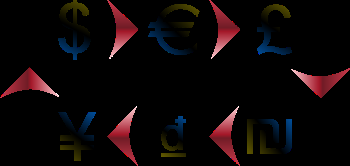
Image used to convey the idea of currency conversion (originally from en.wikipedia). The signs are (clockwise from top-left): dollar, euro, pound, shekel, đồng, yen. (Photo credit: Wikipedia)
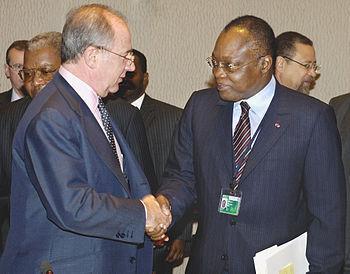
International Monetary Fund Managing Director Rodrigo de Rato (L) greets the G-24 Chairman Paul Toungui of Gabon (R) at the ministerial meeting of the G-24 at International Monetary Fund Headquarters (Photo credit: Wikipedia)
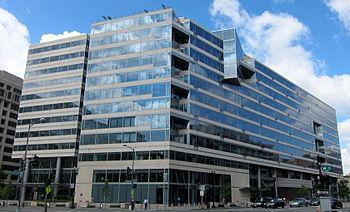
English: The International Monetary Fund (Headquarters 2) located at 1900 Pennsylvania Avenue, N.W., in the Foggy Bottom neighborhood of Washington, D.C. The 12-story, postmodern high-rise was built in 2005 to the designs of Pei Cobb Freed & Partners. (Photo credit: Wikipedia)
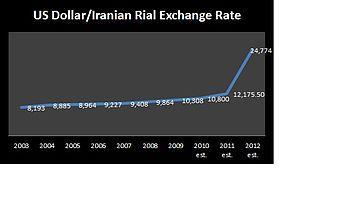
English: US dollar/Iranian rial exchange rates (2003-2010). Note: Iran has been using a managed floating exchange rate regime since unifying multiple exchange rates in March 2002. (Photo credit: Wikipedia)
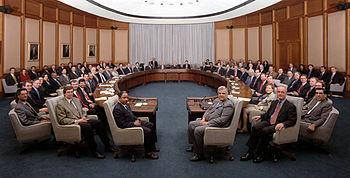
Board of Governors – International Monetary Fund (IMF) (Photo credit: Wikipedia)

English: Member nations of the International Monetary Fund (IMF). (Photo credit: Wikipedia)
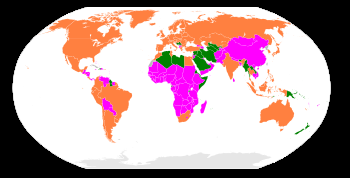
English: IMF Data Dissemination Systems participants IMF member using SDDS IMF member, using GDDS IMF member, not using any of the DDSystems non-IMF entity using SDDS non-IMF entity using GDDS no interaction with the IMF (Photo credit: Wikipedia)
“The International Monetary System involves internationally agreed rules, conventions and supporting institutions, that facilitate international trade, cross border investment and generally the reallocation of capital between nation states.”
To operate appropriately, buyers and sellers of different nationals must feel confident that there is sufficient liquidity to provide for fluctuating levels of trade.
International Monetary systems “can grow organically as the collective result of numerous individual agreements between international economic factors spread over several decades. Alternatively, they can arise from a single architectural vision as happened at Bretton Woods in 1944.”
Chapter Learning Objectives:
Describe the historical development of the modern global monetary system.
Explain the role played by the World Bank and the IMF in the international monetary system.
Compare and contrast the differences between a fixed and a floating exchange rate system.
Identify exchange rate systems that are used in the world today and why countries adopt different exchange rate regimes.
Understand the debate surrounding the role of the IMF in the management of financial crises.
Explain the implications of the global monetary system for currency management and business strategy.
This chapter discusses the evolution of the international monetary system and the implications of this system for international business, focusing on the institutional context within which exchange rates move.
The history of monetary systems includes a period with the gold standard, a fixed exchange rates system, and the current managed float system. Since WWII, the IMF and the World Bank have played an important role in the world economy
The role of the IMF is to maintain order in the international monetary system to avoid a repetition of the competitive devaluations of the 1930s, and to control price inflation by imposing monetary discipline on countries.
IMF-mandated macro economic policies are under serious debate, with critics charging that at times the IMF imposes inappropriate conditions on developing nations.
The opening case explores the recent debt crisis in Ireland that threatened the value of the euro. In order to prevent the crisis from spreading to other countries and to stabilize the euro, the IMF and the EU provided the troubled country with bailout assistance. The closing case examines explores the effect of the 2008 financial crisis on Latvia, and the IMF aid package the country was forced to accept.
OUTLINE OF CHAPTER 11: THE INTERNATIONAL MONETARY SYSTEM
Opening Case: Ireland’s Debt Crisis
Introduction
The Gold Standard
Mechanics of the Gold Standard
Strength of the Gold Standard
The Period between the Wars, 1918-1939
The Bretton Woods System
The Role of the IMF
The Role of the World Bank
The Collapse of the Fixed Exchange Rate System
The Floating Exchange Rate System.
The Jamaica Agreement
Exchange Rates Since 1973
Country Focus: The U.S. Dollar, Oil Prices, and Recycling Petrodollars
Fixed versus Floating Exchange Rates
The Case for Floating Exchange Rates
The Case for Fixed Exchange Rates
Who is Right?
Exchange Rate Regimes in Practice
Pegged Exchange Rates
Currency Boards
Crisis Management by the IMF
Financial Crises in the Post-Bretton Woods Era
Mexican Currency Crisis of 1995
The Asian Crisis
Evaluating the IMF’s Policy Prescriptions
Country Focus: Turkey and the IMF
Implications for Managers
Currency Management
Business Strategy
Corporate-Government Relations
Management Focus: Airbus and the Euro
OPENING CASE: Ireland’s Debt Crisis
The opening case explores the debt crisis in Ireland. After more than a decade of prosperity, Ireland was caught off guard by the 2008-2009 global recession which caused demand for the country’s exports to drop significantly. Unemployment surged and banks, burdened with high levels of bad debt teetered on the verge of collapse. A bailout from the Irish government helped avert disaster, but also pushed the country’s budget deficit to over 30 percent of its GDP and public debt to about 180 percent of GDP. The International Monetary Fund (IMF) and European Union (EU) were ultimately forced to step to prevent the crisis from spreading and to shore up the value of the euro. Discussion of the case can revolve around the following questions.
1. Why was it so important for the IMF and EU to step in to help Ireland in 2010? What were the potential implications of Ireland’s debt crisis for other EU countries? How might the crisis have impacted the entire international monetary system?
2. How did the bailout package help Ireland? What impact did it have the country’s economy and prospects for future growth?
3. Discuss the costs and benefits of doing business in Ireland today. Would you invest in the country?
Read the iGLOBE segments including After Bailout For Irish, Questions Linger Over Portugal, Spain, Ireland’s New Leader Wrestles With Lingering Debt Problems, EU Bailout, and Global Economic Downturn Slams Ireland, Spares Poland.
What is the International Monetary System?
The international monetary system refers to the institutional arrangements that countries adopt to govern exchange rates. Governments adopt various types of exchange rate systems including the pegged rate, the dirty float and the fixed rate.
The Gold Standard
The system of exchange rates known as the gold standard dates back to ancient times when gold coins were a medium of exchange, unit of account, and store of value.
Pegging currencies to gold and guaranteeing convertibility is central to the gold standard.
In the 1880s, most of the world’s trading nations followed this exchange rate system.
Strength of the Gold Standard
The gold standard provides a powerful mechanism to pull trade imbalances between countries back into balance of trade equilibrium.
The Advantages Of The Gold Standard was the topic of a 1961 paper by former Federal Reserve Board Chairman, Alan Greenspan. The paper is available at {http://www.usagold.com/gildedopinion/Greenspan.html}.
The gold standard worked fairly well from the 1870s until the start of World War I in 1914, but by 1939, the gold standard had collapsed.
The Bretton Woods System
The Bretton Woods system established a fixed exchange rate system where all currencies were fixed to gold, but only the U.S. dollar was directly convertible to gold. Devaluations could not to be used for competitive purposes and a country could not devalue its currency by more than 10% without IMF approval.
The Bretton Woods system also provided for two multinational institutions – the International Monetary Fund (IMF) and the World Bank (IBRD).
For more information about the Bretton Woods Agreement go to {http://avalon.law.yale.edu/20th_century/decad047.asp} and also at {http://www.econ.iastate.edu/classes/econ355/choi/bre.htm}.
The IMF and the World Bank
The IMF was charged with executing the main goal of the Bretton Woods agreement – avoiding a repetition of the chaos that occurred between the wars through a combination of discipline and flexibility.
The homepage of the IMF is available at {http://www.imf.org}. Click on either “For First Time Visitors” or on “For Students” to get a good overview of the IMF and its activities.
The World Bank is also known as the International Bank for Reconstruction and Development (IBRD).
For more information on the World Bank, go to {http://www.worldbank.org/index.html}. Click on “Data and Research” to pull information on World Bank activities, or on “Countries” to explore World Bank activities by country.
The Collapse of the Fixed Exchange System
The Bretton Woods worked well until the late 1960s, before collapsing.
The Floating Exchange Rate Regime
The Jamaica Agreement was signed in 1976 following the collapse of Bretton Woods. The rules that were agreed on then are still in place today.
Under the Jamaica agreement:
- floating rates were declared acceptable
- gold was abandoned as a reserve asset
- total annual IMF quotas were increased to $41 billion
Exchange Rates since 1973
Exchange rates have become more volatile and less predictable than they were between 1945 and 1973.
Fixed Versus Floating Exchange Rates
The merit of a fixed exchange rate versus a floating exchange rate system continues to be debated.
The case for floating exchange rates has two main elements:
1. monetary policy autonomy
2. automatic trade balance adjustments
Supporters of fixed exchange rates focus on monetary discipline, uncertainty, and the lack of connection between the trade balance and exchange rates.
Who is Right?
There is no real agreement as to which system is better.
Exchange Rate Regimes in Practice
Currently:
- 14% of IMF members follow a free float policy
- 26% of IMF members follow a managed float system
- 22% of IMF members have no legal tender of their own
- the remaining countries use less flexible systems such as pegged arrangements, or adjustable pegs
Pegged Exchange Rates
A country following a pegged exchange rate system, pegs the value of its currency to that of another major currency.
Currency Boards
Countries using a currency board commit to converting their domestic currency on demand into another currency at a fixed exchange rate.
Crisis Management by the IMF
Today, the IMF focuses on lending money to countries experiencing financial crises.
A currency crisis occurs when a speculative attack on the exchange value of a currency results in a sharp depreciation in the value of the currency, or forces authorities to expend large volumes of international currency reserves and sharply increase interest rates in order to defend prevailing exchange rates.
A banking crisis refers to a situation in which a loss of confidence in the banking system leads to a run on the banks, as individuals and companies withdraw their deposits.
A foreign debt crisis is a situation in which a country cannot service its foreign debt obligations, whether private sector or government debt.
Mexican Currency Crisis of 1995
The Mexican currency crisis of 1995 was a result of:
- high Mexican debts
- a pegged exchange rate that did not allow for a natural adjustment of prices
The Asian Crisis
The 1997 Southeast Asian financial crisis was caused by a series of events that took place in the previous decade.
Evaluating the IMF Policy Prescriptions
Critics of the IMF worry:
- the “one-size-fits-all” approach to macroeconomic policy is inappropriate for many countries
- the IMF is exacerbating moral hazard (when people behave recklessly because they know they will be saved if things go wrong)
- The IMF has become too powerful for an institution without any real mechanism for accountability
Implications for Managers
The present floating rate system mandates that firms carefully manage their foreign exchange transactions and exposures.
Managers must recognize that the current international monetary system is a managed float system in which government intervention can help drive the foreign exchange market.
Managers need strategic flexibility.
Companies should promote an international monetary system that facilitates international growth and development.
Use the globalEDGE™ site {http://globalEDGE.msu.edu/} to complete the following exercises:
Exercise 1
The quality of life in specific markets sometimes is impacted by the country’s financial and fiscal policies. As such, the Global Financial Stability Report is a semi-annual report published by the International Capital Markets division of the International Monetary Fund (IMF). The report aims to provide a regular assessment of global financial markets. Locate and download the latest information to prepare a summary of the top 3 countries that export and import capital.
Exercise 2
An important element to understanding the international monetary system is keeping updated on current growth trends worldwide. A German colleague told you yesterday that Deutsche Bank Research’s Megatopics are an effective way to stay informed on important topics in international finance. Find a Megatopics report for analysis. Is the report on an established or emerging economy? What are the key takeaways from your chosen report?
globalEDGE™ Category: “Money: Finance”



COMMENTS ( 1 )
posted on 02 December at 00:08
Hello colleagues, how is all, and what you wish for to say on the topic of this post, in my view its truly amazing in favor of me.